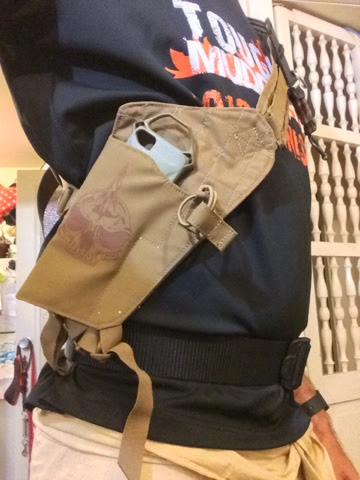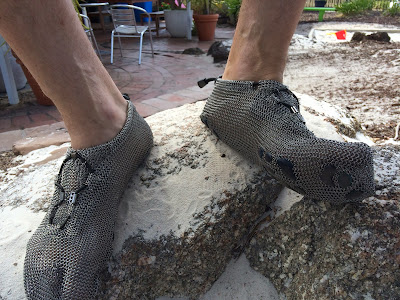
I've been holding off posting on this one till an appropriate juncture, and I think this day has arrived.
This is the Tactical Chef Apron
I'm all for being equipped, and being caught out at the fire-line without the right loadout can mean the difference between slabs of hot steaming, bleeding meat, and charred inedible ruination. That is when having this kind of kit is essential, if not life-saving.
Made of 100% cotton, you can expect the apron to protect your thorax and groin from all but the worst boiling-oil splashbacks, and flare-ups, and perhaps even the exploding kernels of maize.
Featuring a top section of 6 rows of MOLLE loops, with 6 usable channels in the mid chest, and 10 channels at the rib-line, and a further three rows of 10 at the bottom of the apron, this is a modular combat chef's dream.
 Twin sets of triple D-rings, mounted at the upper regions allow for a variety of hung items, and twin snap-clasps at the the waist line give direct attachment and retention options. Three PALS/MOLLE compatible hook-hand-loop fastening pouches, one triple set and two larger sets, one with a look-filed for ID, unit or morale patches offer a variety of mission specific load-outs.
Twin sets of triple D-rings, mounted at the upper regions allow for a variety of hung items, and twin snap-clasps at the the waist line give direct attachment and retention options. Three PALS/MOLLE compatible hook-hand-loop fastening pouches, one triple set and two larger sets, one with a look-filed for ID, unit or morale patches offer a variety of mission specific load-outs.The lower section of the apron features three dump-pouch pockets, for a variety of accessory and brain-grenade carriage capacity. Watch out for the pocket stitching cutting through MOLLE loops though.
The wide shoulder straps are not adjustable, but come "hero-sized". Fastex style clasps secure front and back, with webbing sliders expanding to allow for the more substantially proportioned combat-chefs.
The back features even more MOLLE loops as well as a broad loop-field for further ID and insignia.
 | |
| Click the picture to be taken to ThinkGeek to buy one! |
This is a fun piece, which I enjoy throwing on whenever I face flames, steaming flesh and the wailing of mouths, screaming for blood.


























